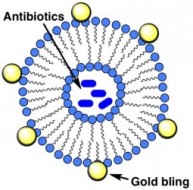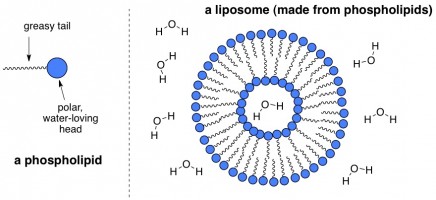Targeted drug delivery is a popular area of research that melds together the disciplines of chemistry, medicine, and materials. The basic idea is to develop ways to give a person a dose of medicineorally, intravenously, etc. and somehow get that medicine to go to exactly the part of the body that needs it most – and preferably nowhere else. An article recently published in JACSJournal of the American Chemical Society describes a clever method of antibiotic delivery that involves fat blobs, gold particles, and their interaction with the toxins released by infectious bacteria.
 One approach to targeted drug delivery is to design nanoparticle delivery devices, kind of like tiny FedEx trucks, that can travel through your bloodstream. These nanoparticles – which are way smaller than the naked eye can see – are ideally made of some inert substance that doesn’t affect the body at all. Drug molecules are encapsulated within the nanoparticles, and the little vehicles escort the drug to its “target” in the body. Upon arrival at the desired destination, a well-behaving nanoparticle releases its cargo of drug molecules, so they can get to work healing the body.
One approach to targeted drug delivery is to design nanoparticle delivery devices, kind of like tiny FedEx trucks, that can travel through your bloodstream. These nanoparticles – which are way smaller than the naked eye can see – are ideally made of some inert substance that doesn’t affect the body at all. Drug molecules are encapsulated within the nanoparticles, and the little vehicles escort the drug to its “target” in the body. Upon arrival at the desired destination, a well-behaving nanoparticle releases its cargo of drug molecules, so they can get to work healing the body.
Unfortunately, it’s tricky to coax nanoparticles to (a) go where you want them to go and (b) not leak drug molecules out too early. This new research by Zhang et al. tries to address these problems.
The authors use liposomes – speckled with gold dust! – as nanocarriers for the antibiotic vancomycin. The gold dust has a purpose besides bling, but we’ll get to that in a minute.
Liposomes. Liposomes are basically miniscule blobs of fat that have a hollow center (which is typically filled with water and stuff). The reason for this spherical structure is actually pretty logical.
The fat molecules (phospholipids) that make up liposomes have long greasy tails, which have zero interest in mixing with any water-based fluids such as blood. But at the end of each tail is a non-greasy cluster of atoms; this end of the molecule actually enjoys being exposed to water. Because each fat molecule is amphiphilicloves different, opposing things, kind of like an amphibian likes both water and land like this – one side likes water and the other doesn’t – the molecules arrange themselves into a structure in which everyone wins. The fatty (nonpolar) tails just hang out with each other and the polar, water-loving heads face the water-rich outside or inside of the sphere:
Liposome Interaction With Bacterial Toxins. The good thing about liposomes for drug delivery is that the phospholipid bilayer very much resembles the protective envelope that encapsulates cells. It is known that certain toxins released by bacteria are toxic because they puncture holes in cell membranes. Thus, these toxins should be expected to puncture holes in liposomes as well, which would mean that the presence of bacterial toxins would enable liposome cargo to leak out.
Keeping the Liposomes from Leaking too Early. Now, the insides of the liposome spheres can be loaded with drug molecules. This trick has been done before, but researchers have found that the integrity of the fatty envelope gets compromised all too easily when liposomes are put into a human or animal body. This means that drug molecules just spill out everywhere almost immediately. This would be like a FedEx truck’s back door sliding open on the freeway and packages flying out everywhere. Delivery sort of happened – the packages are no longer in possession of FedEx – but it wasn’t on target.
 So that’s why the researchers decided to cover the liposomes with gold. The gold dust nanoparticles, which are themselves coated with positively charged organic moleculeschitosan, to be precise, serve as a sort of armor for the liposome trucks. This gold armor prevents the liposomes from squishing together and squeezing out their cargo en route to the destination. Chemically speaking, this works because the positively-charged gold nanoparticles on the surface of the liposomes repel each other – positive charges don’t want to interact with other positive charges – so individual liposomes keep a safe distance from one other.
So that’s why the researchers decided to cover the liposomes with gold. The gold dust nanoparticles, which are themselves coated with positively charged organic moleculeschitosan, to be precise, serve as a sort of armor for the liposome trucks. This gold armor prevents the liposomes from squishing together and squeezing out their cargo en route to the destination. Chemically speaking, this works because the positively-charged gold nanoparticles on the surface of the liposomes repel each other – positive charges don’t want to interact with other positive charges – so individual liposomes keep a safe distance from one other.
Testing the Delivery Device. First, the researchers filled the gold-coated liposomes with dye molecules. When the dye molecules were tucked inside the liposomes, they were invisible to the watching scientists, but if they escaped the liposome trucks they became visible. The researchers tried putting the dye-filled liposomes in a variety of situations, including in the presence of a bacterial toxin. They saw that the dye stayed hidden inside the liposomes when there was no toxin around, but when the liposomes came into the vicinity of the membrane-piercing toxin, dye molecules started leaking out all over the place. Perfect.
Vancomycin Delivery to MRSA Bacteria. The final step was to test the gold-speckled liposomes in a semi-real-life situation. The liposomes were loaded up with the antibiotic vancomycin and, like with the dyes, checked to be sure they didn’t leak when they shouldn’t. Then they were placed in the presence of MRSAMethicillin-resistant Staphylococcus aureus – a nasty bacterium – to assess whether or not the toxins given off by MRSA would puncture the liposome walls and let vancomycin escape. Sure enough, vancomycin started leaking out.

The diabolic MRSA produced toxins designed to punch holes in human cells, but in an ironic twist of fate, the toxins instead punched holes in the antibiotic delivery trucks. Long story short, the vancomycin escaped the compromised liposomes and killed off the MRSA. The bacteria had shot themselves in the foot.
Citation:
Pornpattananangkul, D., Zhang, L., Olson, S., Aryal, S., Obonyo, M., Vecchio, K., Huang, C., & Zhang, L. (2011). Bacterial Toxin-Triggered Drug Release from Gold Nanoparticle-Stabilized Liposomes for the Treatment of Bacterial Infection Journal of the American Chemical Society DOI: 10.1021/ja111110e



